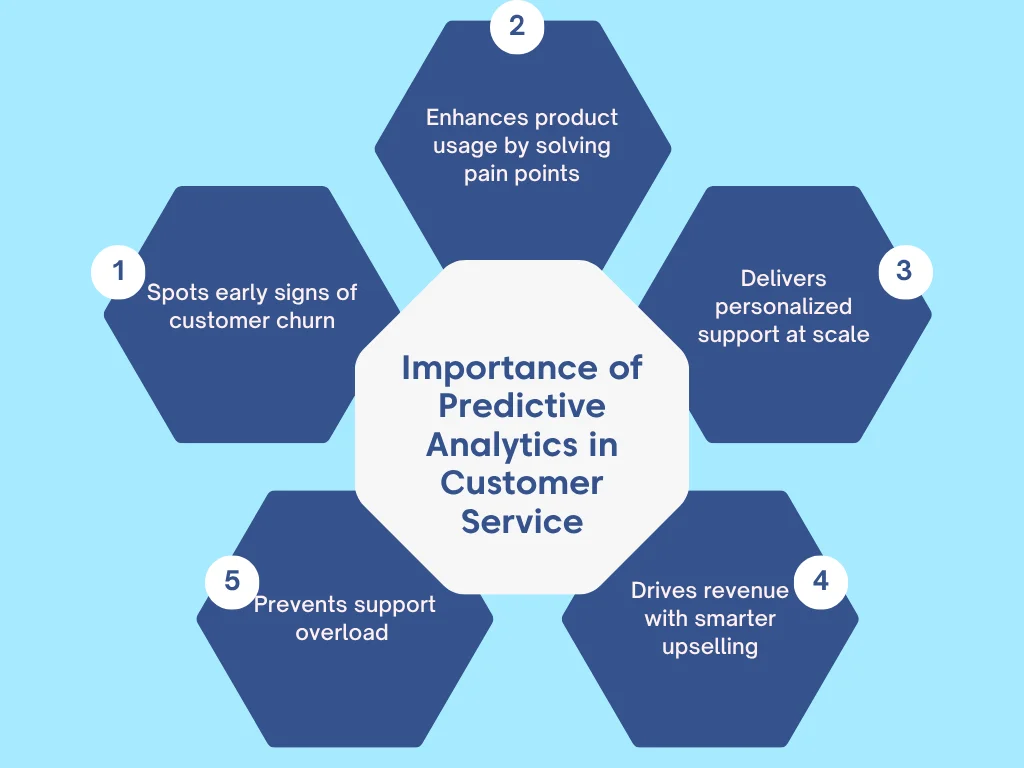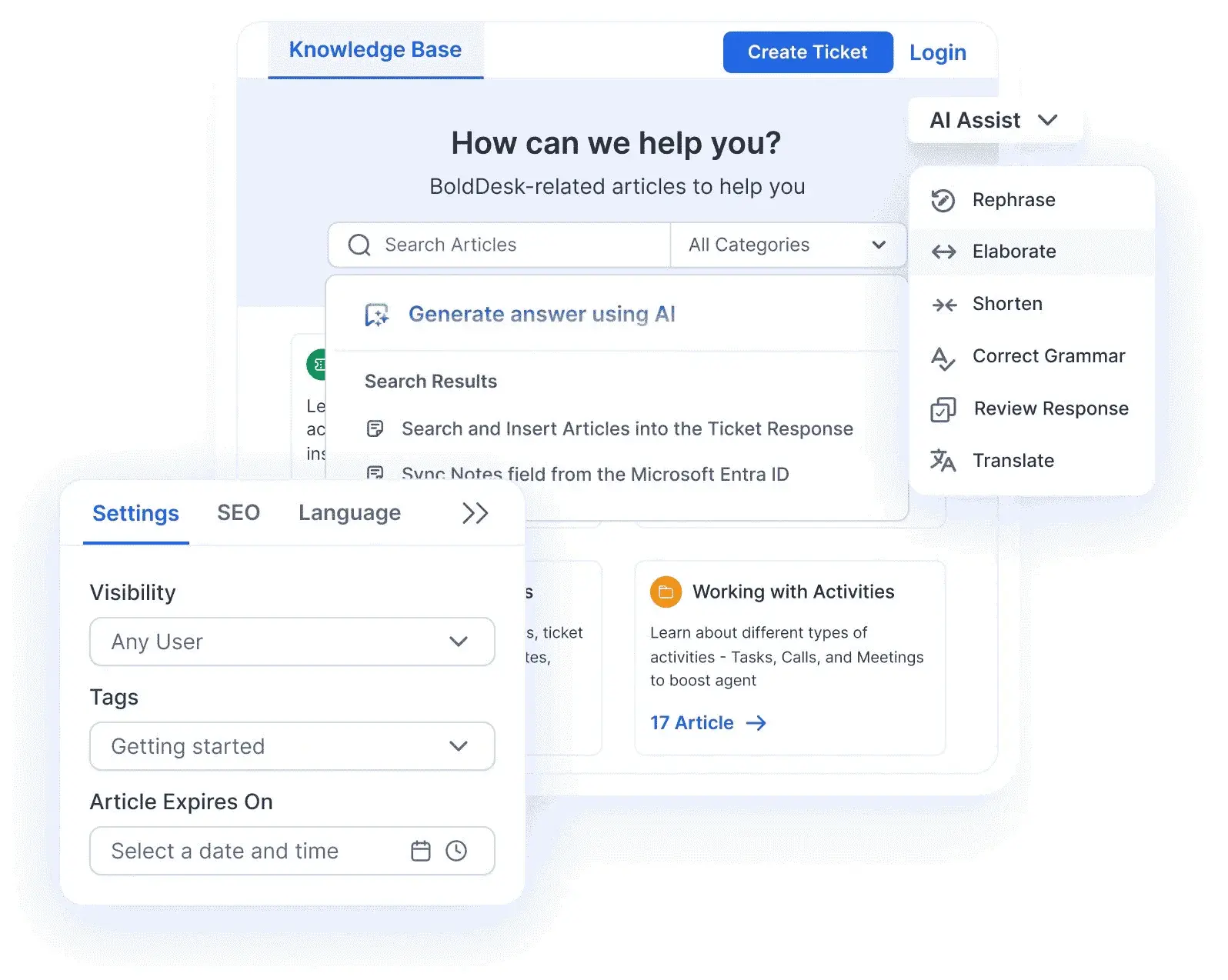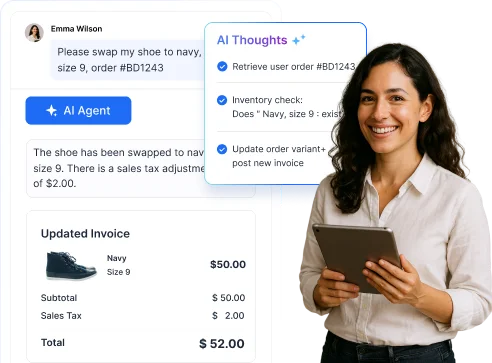What if you could know exactly which customers will reach out tomorrow, what issues they’ll face, and how to resolve them before they even ask?
With that kind of foresight, it becomes easier to prepare, prioritize, and stay ahead of service demands.
Predictive analytics in customer service makes this possible by uncovering patterns in existing data to anticipate customer needs before they turn into problems.
In this blog, we’ll explore what predictive analytics in customer service really means, its key benefits, important features, best practices, and real-world examples.
What are predictive analytics in customer service?
Predictive analytics in customer service refers to the use of historical data, artificial intelligence, statistical algorithms, and machine learning to anticipate future customer behaviors, potential issues, and service needs.
Predictive customer service analytics analyzes data such as support tickets, chat transcripts, product usage, website activity, purchase history, and survey feedback.
By identifying patterns and spotting trends, it forecasts potential customer behaviors, issues, and needs.
This allows support teams to respond proactively, resolve problems faster, and deliver more effective, personalized services using insights powered by artificial intelligence, statistical algorithms, and machine learning.
Why predictive analytics in customer service matters
The best businesses don’t wait for problems to appear, they detect early signs and take action that smooths the customer’s journey.
Here are some of the key benefits of implementing predictive analytics for customer support.

- Spots early signs of customer churn: Predictive support models watch for warning signs like fewer logins, negative messages, or slow replies. If a customer seems like they might stop using your service, the system flags them early so your support agents can reach out and keep them from leaving.
- Enhances product usage by solving pain points: If customers often get stuck during onboarding or stop using a feature, predictive customer analytics tools notice the pattern, helping your support team guide users hence improving their experience and encouraging long-term use.
- Delivers personalized support at scale: Predictive customer analytics helps support teams quickly identify customer needs and suggest the most relevant solutions based on past behavior and interactions.
- Drives revenue with smarter upselling: The system can identify when a customer is likely to benefit from a new feature or upgrade based on how they use your product. That means your team can recommend the right offer at the right time, boosting customer satisfaction and sales.
- Prevents support overload by forecasting ticket volumes: Predictive models learn from past support activity, product updates, and seasonal spikes to guess when more help requests will come in. This helps you schedule the right number of agents, so users aren’t kept waiting and your team isn’t overwhelmed.
Key features of predictive analytics in customer service
Customer service predictive analytics is transforming how businesses approach customer service. Instead of reacting to issues after they happen, support teams can now use data to anticipate what’s coming next.
Below are the key features that define how predictive analytics in customer service works:

Data-driven issue prediction
Predictive models analyzes both past records and current real-time information to predict what problems customers might face in the future.
When your business reviews this data, it can spot issues before they happen and fix them early saving time and keeping customers happy.
Real-time customer monitoring and assistance
Predictive analytics and AI-powered search are reshaping customer service by continuously monitoring user behavior to detect early signs of issues such as declining engagement or unusual activity.
This enables businesses to proactively offer support, often before customers even realize they need help, fostering a truly responsive and customer-centric service culture.
By 2025, AI is expected to handle an astonishing 95% of all customer interactions, transforming how businesses engage with their clients.
For example, tools like BoldDesk utilize AI-driven predictive search to help users easily find answers within a knowledge base, highlighting AI’s critical role in proactive customer service strategies.

Automated alerts and troubleshooting
Once a predictive analytics customer service model detects a potential issue, it can automatically send alerts to internal support teams or directly to customers.
These alerts can trigger specific actions, such as sharing troubleshooting guides, opening a support ticket, or prompting the user with in-app messages.
Predictive resource allocation
Support planning involves analyzing historical support data such as peak seasons and common issue types to predict future demand.
By leveraging these insights, models for predictive analytics in customer service can recommend how many support agents may be needed and where they should be allocated.
Personalized support recommendations
Predictive analytics customer service models use customer behavior, purchase history, and past support interactions to personalize support experiences.
Based on the data, predictive models can recommend relevant help center articles, direct tickets to the most suitable agent, or suggest the most effective customer service channel such as SMS, social media, or email.
These recommendations rely on recognizable patterns and stored user profiles to enhance service efficiency and satisfaction.
Churn risk detection
Churn prediction models evaluate customer activity and identify accounts that may stop using the service.
Predictive analytics checks for signs like reduced engagement, repeated customer complaints, or skipped renewals. A customer’s risk of leaving is updated whenever new data is added.
Sentiment analysis
Sentiment analysis uses natural language processing (NLP) to analyze written text such as support chats, emails, and reviews.
The process identifies the tone of the conversation (positive, negative, or neutral) by evaluating word choice, punctuation, and sentence structure.
Based on the score sentiment scores are assigned to help track customer mood and tone over time.
Common challenges in predictive customer analytics
Predictive data analytics in customer service helps teams anticipate customer insights by analyzing past interactions.
But making it work in real-world service environments isn’t simple, here are some of the challenges that often get in the way.
Predictive analytics in customer service works best when the data is accurate. If the data is old or unfair, the predictions can be wrong, which may lead to bad decisions.
Making good predictive models is hard without the right skills, leading to wrong predictions and wasted time or funds.
Examples of customer service predictive analytics in various industries
Predictive analytics is already making waves in customer service, offering innovative ways to enhance customer experience and streamline operations.
Wondering how businesses are leveraging it? Here are some real-world examples of how predictive analytics is applied in customer service.
E-commerce and retail
When a customer browses or purchases items on an online platform, predictive analytics collects valuable data such as past purchases, browsing history, items frequently bought together, product reviews and ratings, cart additions and wish lists.
Using predictive analytics, this data is analyzed to:
- Recommend products the customer is likely to buy next
- Predict demand for certain products
- Personalize homepage content and promotional emails
- Optimize inventory and pricing strategies
Example: Amazon’s product recommendation
Amazon, a global technology company based in U.S, handles millions of customer interactions every day and uses predictive analytics to tailor its recommendations, ensuring customers discover products that perfectly match their preferences and needs.
For example, if someone buys a smartphone, Amazon looks at their browsing and purchase history plus what similar customers did and suggests what they might need next, like a phone case or charger. This helps Amazon offer helpful suggestions before the customer even asks, making the experience easier and more satisfying.
Telecommunication
When a customer uses a telecom service, the predictive models collect valuable data such as call and data usage patterns, customer service interactions, payment history and billing issues, network performance in the user’s location, feedback from surveys or social media.
Example: Verizon’s customer retention strategy
Handling over 170 million customer calls annually, Verizon, a top telecommunication company, faces the challenge of delivering fast and accurate support at scale. To meet this demand, it leverages generative AI to predict the reason for a customer’s call with up to 80% accuracy even before the customer speaks to an agent.
The AI looks at past data and customer behavior to guess what the caller needs, helping route calls faster and more accurately. This means shorter wait times, quicker help, and a smoother experience.
Financial services
When a customer interacts with a financial institution, the predictive analytics collects valuable data such as transaction history and spending patterns, login behavior and device usage, location data and travel activity, past fraud alerts and resolution outcomes, customer support queries and feedback.
Using predictive analytics customer service tools, this data is analyzed to:
- Spot unusual or suspicious transactions quickly
- Know when a customer might need help
- Send helpful alerts and tips through virtual assistants
- Pass complex issues to expert support staff
Example: Bank of America’s fraud detection and virtual assistant
With over 26 billion digital interactions each year and more than 20 million users of its AI assistant Erica, the Bank of America, one of the world’s widest financial institutions, can predict why a customer is reaching out.
For example, it can detect a suspicious transaction by analyzing account activity, freeze possible fraud and alert the customer instantly through Erica.
Step into the future with predictive analytics in customer service
The future of customer service isn’t reactive; it’s predictive. Predictive analytics empowers businesses to anticipate needs before they arise, using data-driven insights for timely, personalized support.
This approach goes beyond data collection. By analyzing behavior and identifying trends, companies can deliver smarter, faster, and more human service.
The shift from reactive to proactive support isn’t just a trend, but a technical imperative for scalable, intelligent customer experiences.
If you have any thoughts or questions, feel free to contact the BoldDesk support team at any time.
We hope this article is helpful. Let us know what you think in the comments section below.
Related articles



















 Email Ticketing System
Email Ticketing System Shared Inbox Software
Shared Inbox Software Multi Brand Help Desk
Multi Brand Help Desk Internal Help Desk Software
Internal Help Desk Software Trouble Ticketing Software
Trouble Ticketing Software Mobile Help Desk
Mobile Help Desk 
















